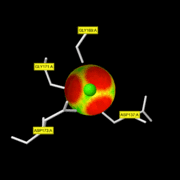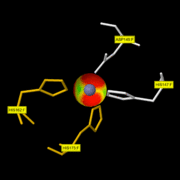Sandbox Reserved 1125
From Proteopedia
(Difference between revisions)
| Line 58: | Line 58: | ||
== Mechanism == | == Mechanism == | ||
| - | MMP-8 is secreted as inactive proproteins and then activated after a cleavage by extracellular proteinases. Indeed, it can't be activated without removal of the activation peptide. After this protease | + | MMP-8 is secreted as inactive proproteins and then activated after a cleavage by extracellular proteinases. Indeed, it can't be activated without removal of the activation peptide. After this protease activation, recent evidences suggest that, there is formation of an intramolecular complex between the Cysteine residue (Cys91) of the propeptide domain and essential zinc atom in the catalytic domain. It is called the ''Cysteine-switch'': it inhibits the action of MMP-8. This discovery is unprecedented in enzymology and offers the opportunity for multiple modes of physiological activation of MMP-8. Moreover, since conditions in different cells and tissues may match those necessary to effect one of these activation modes for a given MMP, this may offer metabolic flexibility in the control of MMP activation.<ref>PMID:2164689</ref> |
To express collagenolytic activity, MMP-8 needs to have both the catalytic and hemopexin domains. The linker peptide can position the hemopexin domain in such a way that it bends over the active site of the catalytic domain. But understanding how the Hemopexin domain assists in the cleavage of collagen is elusive.<ref>PMID:15257288</ref> Thus, the collagen would be captured between these two domains. However, the active site cannot accommodate the entire triple helix in a native state. The linker peptide would, by means of its collagen-like conformation, change the quaternary structure of the captured collagen. Interactions between proline residues of the collagenase and a specific region of the collagen would generate a “proline zipper,” resulting in destabilization of the cleavage site area of the collagen. After destabilization, one chain of the triple helix fits in the specificity pocket or <scene name='71/719866/S1prime_pocket/1'>S1' pocket</scene> to the right of the active-site zinc. At first, the Gly residue of the substrate binds the <scene name='71/719866/Catalytic_site/4'>active site</scene> thanks to the Zn2+ atom. When it binds it takes the place of unstable water molecules and establishes stabilizing interactions with the active site thanks to its C terminal part.<ref>PMID:17185359</ref> The carboxyl group of the glutamate serves as a general base to draw a proton from the displaced water molecule, thereby facilitating the nucleophilic attack of the water molecule on the carbonyl carbon of the peptide scissile bond. Then, the Alanine residue of the enzyme makes a hydrogen bond with the NH group of the substrate. Moreover, this NH group becomes the new N-terminus after cleavage.<ref>PMID:12730128</ref> | To express collagenolytic activity, MMP-8 needs to have both the catalytic and hemopexin domains. The linker peptide can position the hemopexin domain in such a way that it bends over the active site of the catalytic domain. But understanding how the Hemopexin domain assists in the cleavage of collagen is elusive.<ref>PMID:15257288</ref> Thus, the collagen would be captured between these two domains. However, the active site cannot accommodate the entire triple helix in a native state. The linker peptide would, by means of its collagen-like conformation, change the quaternary structure of the captured collagen. Interactions between proline residues of the collagenase and a specific region of the collagen would generate a “proline zipper,” resulting in destabilization of the cleavage site area of the collagen. After destabilization, one chain of the triple helix fits in the specificity pocket or <scene name='71/719866/S1prime_pocket/1'>S1' pocket</scene> to the right of the active-site zinc. At first, the Gly residue of the substrate binds the <scene name='71/719866/Catalytic_site/4'>active site</scene> thanks to the Zn2+ atom. When it binds it takes the place of unstable water molecules and establishes stabilizing interactions with the active site thanks to its C terminal part.<ref>PMID:17185359</ref> The carboxyl group of the glutamate serves as a general base to draw a proton from the displaced water molecule, thereby facilitating the nucleophilic attack of the water molecule on the carbonyl carbon of the peptide scissile bond. Then, the Alanine residue of the enzyme makes a hydrogen bond with the NH group of the substrate. Moreover, this NH group becomes the new N-terminus after cleavage.<ref>PMID:12730128</ref> | ||
Revision as of 11:55, 30 January 2016
Matrix metalloproteinase-8
MMP-8, also called, Neutrophil collagenase or Collagenase 2, is a zinc-dependent and calcium-dependent enzyme. It belongs to the Matrix metalloproteinase
(MMP) family which is involved in the breakdown of extracellular matrix in embryonic development, reproduction, and tissue remodeling, as well as in disease processes, such as arthritis and metastasis. The gene coding this family is localized on the chromosome 11 of Homo sapiens with 467 residues.[1]
| |||||||||||
References
- ↑ "MMP-8 matrix metallopeptidase 8 (neutrophil collagenase)"
- ↑ "Metalloendopeptidase activity"
- ↑ [1]
- ↑ Stams T, Spurlino JC, Smith DL, Wahl RC, Ho TF, Qoronfleh MW, Banks TM, Rubin B. Structure of human neutrophil collagenase reveals large S1' specificity pocket. Nat Struct Biol. 1994 Feb;1(2):119-23. PMID:7656015
- ↑ 5.0 5.1 Substrate specificity of MMPs
- ↑ Bode W, Reinemer P, Huber R, Kleine T, Schnierer S, Tschesche H. The X-ray crystal structure of the catalytic domain of human neutrophil collagenase inhibited by a substrate analogue reveals the essentials for catalysis and specificity. EMBO J. 1994 Mar 15;13(6):1263-9. PMID:8137810
- ↑ Bode W, Reinemer P, Huber R, Kleine T, Schnierer S, Tschesche H. The X-ray crystal structure of the catalytic domain of human neutrophil collagenase inhibited by a substrate analogue reveals the essentials for catalysis and specificity. EMBO J. 1994 Mar 15;13(6):1263-9. PMID:8137810
- ↑ http://www.sciencedirect.com/science/article/pii/S0014579397001580
- ↑ Hirose T, Patterson C, Pourmotabbed T, Mainardi CL, Hasty KA. Structure-function relationship of human neutrophil collagenase: identification of regions responsible for substrate specificity and general proteinase activity. Proc Natl Acad Sci U S A. 1993 Apr 1;90(7):2569-73. PMID:8464863
- ↑ Van Wart HE, Birkedal-Hansen H. The cysteine switch: a principle of regulation of metalloproteinase activity with potential applicability to the entire matrix metalloproteinase gene family. Proc Natl Acad Sci U S A. 1990 Jul;87(14):5578-82. PMID:2164689
- ↑ Chung L, Dinakarpandian D, Yoshida N, Lauer-Fields JL, Fields GB, Visse R, Nagase H. Collagenase unwinds triple-helical collagen prior to peptide bond hydrolysis. EMBO J. 2004 Aug 4;23(15):3020-30. Epub 2004 Jul 15. PMID:15257288 doi:http://dx.doi.org/10.1038/sj.emboj.7600318
- ↑ Piccard H, Van den Steen PE, Opdenakker G. Hemopexin domains as multifunctional liganding modules in matrix metalloproteinases and other proteins. J Leukoc Biol. 2007 Apr;81(4):870-92. Epub 2006 Dec 21. PMID:17185359 doi:http://dx.doi.org/10.1189/jlb.1006629
- ↑ Visse R, Nagase H. Matrix metalloproteinases and tissue inhibitors of metalloproteinases: structure, function, and biochemistry. Circ Res. 2003 May 2;92(8):827-39. PMID:12730128 doi:http://dx.doi.org/10.1161/01.RES.0000070112.80711.3D
- ↑ Knauper V, Docherty AJ, Smith B, Tschesche H, Murphy G. Analysis of the contribution of the hinge region of human neutrophil collagenase (HNC, MMP-8) to stability and collagenolytic activity by alanine scanning mutagenesis. FEBS Lett. 1997 Mar 17;405(1):60-4. PMID:9094424
- ↑ "Neutrophil collagenase"
- ↑ Visse R, Nagase H. Matrix metalloproteinases and tissue inhibitors of metalloproteinases: structure, function, and biochemistry. Circ Res. 2003 May 2;92(8):827-39. PMID:12730128 doi:http://dx.doi.org/10.1161/01.RES.0000070112.80711.3D
- ↑ Nagase H, Visse R, Murphy G. Structure and function of matrix metalloproteinases and TIMPs. Cardiovasc Res. 2006 Feb 15;69(3):562-73. Epub 2006 Jan 5. PMID:16405877 doi:http://dx.doi.org/10.1016/j.cardiores.2005.12.002
- ↑ http://www.rcsb.org/pdb/explore/explore.do?structureId=1UEA
- ↑ Baker AH, Edwards DR, Murphy G. Metalloproteinase inhibitors: biological actions and therapeutic opportunities. J Cell Sci. 2002 Oct 1;115(Pt 19):3719-27. PMID:12235282
- ↑ "Extra Binding Region Induced by Non-Zinc Chelating Inhibitors into the S1′ Subsite of Matrix Metalloproteinase 8"
- ↑ Balbin M, Fueyo A, Knauper V, Pendas AM, Lopez JM, Jimenez MG, Murphy G, Lopez-Otin C. Collagenase 2 (MMP-8) expression in murine tissue-remodeling processes. Analysis of its potential role in postpartum involution of the uterus. J Biol Chem. 1998 Sep 11;273(37):23959-68. PMID:9727011
RESSOURCE : Image:2oy4 mm1.pdb ( la structure du monomère )


